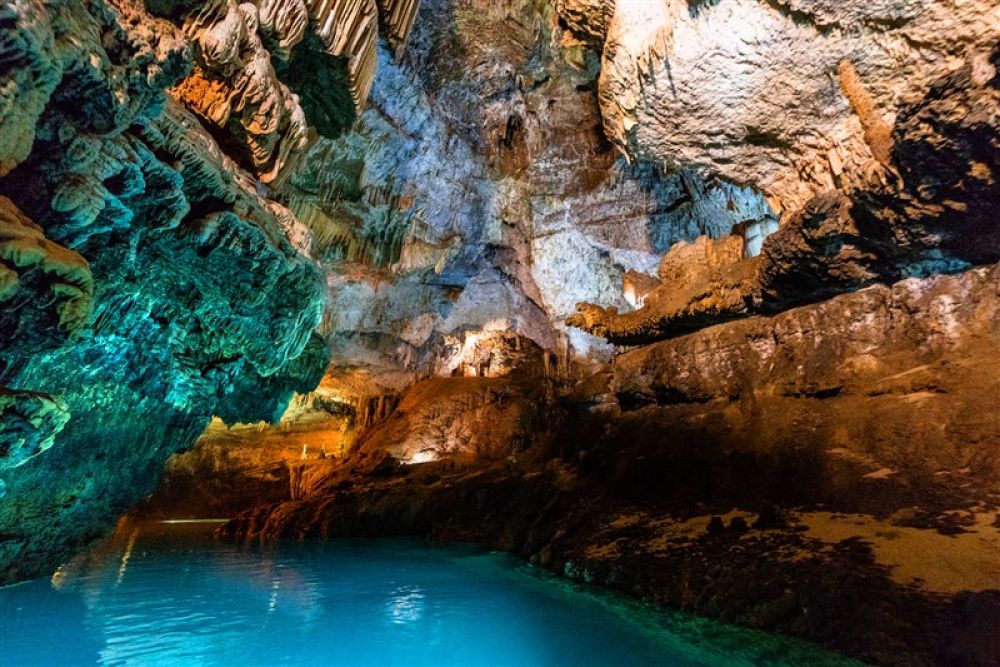

Located in the Nahr al-Kalb valley, just 18 kilometers north of Beirut, the Jeita Grotto in Lebanon is a compound of crystalline limestone caves, known for their spectacular stalactites and stalagmites. This natural wonder is one of Lebanon’s top tourist attractions and a candidate for the New 7 Wonders of Nature. Jeita Grotto offers a magical journey through two separate, yet interconnected, limestone caves which house some of the longest stalactites in the world.
The Jeita Grotto was formed millions of years ago through the dissolution of limestone by infiltrating water. The grotto is split into two parts: the upper galleries and the lower galleries. The upper gallery is known for its impressive stalactite formations, which hang from the ceiling like chandeliers, each formed by the slow deposition of calcium carbonate and other minerals from dripping water. The lower gallery, accessible by boat due to its subterranean river, boasts towering stalagmites that rise from the ground towards the light, creating an almost surreal, fantastical landscape.
The discovery and exploration of the Jeita Grotto date back to the 19th century. Initially explored in 1836 by William Thomson, it was not until 1958 that the Lebanese Caving Club opened the grotto to the public. Since then, tourism facilities have been developed, including pathways, lighting, and a cable car, making the exploration of the grotto safer and more accessible.
Over the years, Jeita Grotto has become a significant cultural icon and a pivotal part of Lebanon's tourism industry, inspiring eco-tourism projects and geotourism across the region. In the 20th century, the grotto was nominated for international recognition several times and has been included in many international publications and television programs. Efforts to preserve this natural treasure continue to be a priority for the Lebanese authorities and environmental organizations.
The latest trends in tourism at Jeita Grotto reflect a growing interest in sustainable and eco-friendly travel. Visitors are increasingly seeking experiences that are not only memorable but also responsible towards nature and local communities. This has led to initiatives aimed at preserving the grotto and its surroundings, educating visitors about the importance of conservation, and promoting the use of environmentally friendly practices within the tourism sector.
As part of these trends, Jeita Grotto has implemented measures to minimize its environmental impact, such as efficient lighting systems and waste management protocols. Further, the tourism services offered by Jeita have evolved, incorporating digital guides and virtual tours for those who cannot visit in person, providing a comprehensive experience while emphasizing the importance of protecting this geological marvel.
When planning your visit to Jeita Grotto, remember that photography is strictly prohibited inside the caves to preserve the natural environment. However, you can take with you the memories of the enchanting world beneath the earth's surface. Tickets to Jeita Grotto generally include access to both the upper and lower galleries, and guides are available to enrich your visit with knowledge about the geological and historical significance of this natural phenomenon.
Whether you are a nature lover, a geology enthusiast, or simply looking for a unique experience, Jeita Grotto welcomes you to discover its timeless beauty. The serene ambiance, massive geological formations, and the sheer magnificence of nature's artwork are sure to leave you in awe.
Prepare for your visit: As the caves maintain a constant cool temperature, it’s advisable to bring a light jacket. Flat, sturdy shoes are also recommended for navigating the wet surfaces inside the grotto.
The Jeita Grotto continues to captivate tourists from around the world, leaving an indelible impression of Lebanon's rich natural heritage and its endless wonders.